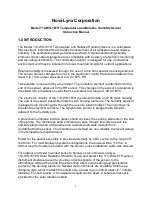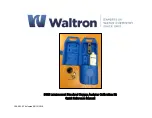
8
7. Do not operate the humidity probe for long periods with the protective membrane
removed.
8. Do not attempt to clean the RH sensing element.
6.0 TROUBLESHOOTING
The Model 110-WS-16TH Temperature and Relative Humidity Sensor is a simple
instrument to use and, except for possible contamination of the humidity sensing
element, it should be virtually trouble-free.
Always disconnect the input power and begin to troubleshoot immediately whenever
any of the following conditions occur: the instrument does not produce an output signal;
the output signal appears to be missing; the output signal exhibits a marked change in
performance; the instrument has been dropped or damaged; lighting has struck near
the sensor; moisture has invaded the vapor membrane and plastic shield.
6.1 Power Problems
If the sensor’s output signal appears to be in error or is absent, check the power
connections. At the sensor cable, measure the battery or the input power source
voltage with a voltmeter. Be sure that the instrument has been powered up correctly or
wait for the next power ON cycle to occur. Check any batteries to be sure that they
have sufficient charge and an adequate voltage level to power the instrument and that
all connections are secure. Inspect the battery terminals to ensure that they are clean
and solidly connected to the battery.
6.2 Determining the Source of a Failure
To determine whether the trouble is in the sensor or the electronics, try to manually
operate the sensor by increasing the relative humidity or temperature near the sensor.
Changing the humidity can isolate a defective RH sensing element quickly. Breathing
heavily onto the humidity sensor should produce an immediate increase in the humidity
output signal. Holding the end of the sensor tightly for a brief time should give an
elevated temperature reading. If it is impossible to locate the problem, contact
NovaLynx to return the unit to the factory. If the translator electronics respond properly
to simulated sensor inputs then the trouble may be somewhere in the sensor. If there is
no humidity sensor signal or if the humidity signal does not change with a change in the
humidity, the sensing element may be defective. The same is true of the temperature
sensor. The thermistor plugs into the two terminals next to the RH sensor. Inspect the
thermistor leads for corrosion. Remove any corrosion or dirt between the leads. If spare
sensing elements are not available, contact NovaLynx.































